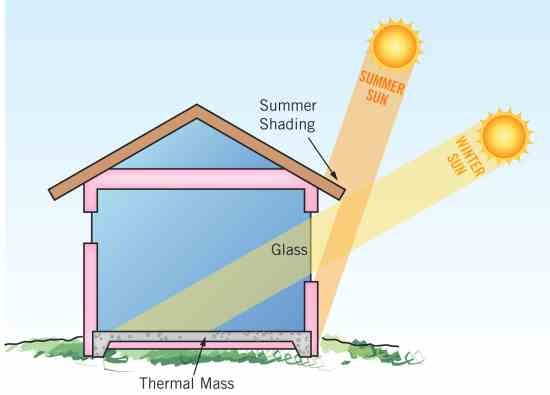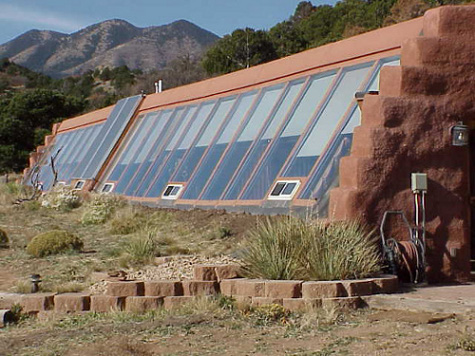A Critical Day Tomorrow for Passive Solar Design - Don't Miss It!
.jpg)
If you are a homesteader, someone who wants to live off-grid, or just someone who is interested in passive solar heating, tomorrow (Dec. 21) is a big day! Of course, that is because it is the winter solstice. As most of you are aware, that means that it is the shortest day of the year. After tomorrow, days start (thankfully) getting longer again. But the amount of daylight is not what makes tomorrow so important for passive solar design.
So Why Is It So Important?
Good question! To put it simply, tomorrow is the day of the year - for those of us in the northern hemisphere - when the sun at noon is the lowest it will ever be. And that, as you will soon understand, is of vital importance!
Obviously, winter is the coldest time of the year, and that is the time of year that you will want to take advantage of the sun's heat to full effect. You want to allow as much of that sunlight into your home as possible in order to heat up your home (which hopefully incorporates some form of thermal mass!). And there are two things you need to pay attention to:
1) In which compass direction is the sun?
Do you know the answer? Well, during the winter, the sun is always in the southern half of the sky (again, for those of us in the northern hemisphere). And even though this is probably obvious to most of you, it is still very important to mention that whatever side the sun shines on will be able to absorb its heat. So, you are going to want to face the front of your house towards the south. (If you want to get technical, most designers would tell you to face your building slightly east of south to take advantage of the sun's warmth earlier in the day.)
Now, I know this is not the norm for those of us here in the US of A as we always face our house towards the road - even it is due north! That is because we are so used to controlling the climate within our homes using very energy-intensive mechanical means. However, this was not always so. Pretty much every culture in the northern hemisphere would face the front of their houses towards the south. (Some still do, by the way. When I was in China, it was a big selling point to have an apartment that faced south.) Anyway, let's move on to the second point.
2) What is the angle between the sun and the horizon?
In case you did not know, the sun's angle with respect to the horizon changes throughout the year. It goes from its lowest noontime point on the winter solstice to its highest noontime point during the summer solstice. Every day, the angle between the sun and the horizon changes ever so slightly.

So, why does this matter if your home is already facing south? Well, it has to actually do with the reflective and transmissive properties of glass windows. Light may seem to pass through glass perfectly at any angle, but this is actually not so. Even the clearest glass will reflect some light. And the amount that is reflected or transmitted varies according to the angle that the light hits the window. For optimal transmittance, you want the light to hit the glass straight on at a 90-degree angle (that is perpendicular to the surface of the glass).
In an optimal passive solar design, the windows are not placed in a perfectly vertical wall. The wall with the window is angled with respect to the sun. And the angle used is found on the winter solstice! What you want is for the sun's light to hit the south-facing windows at a 90-degree angle. (Notice the angled windows in the home shown below.)

So, make the most of tomorrow and see where in the sky the sun is at its highest point. Take note of it because it will be important in any home with a passive solar design. And even if you don't care all that much about the angle, you can also just make sure that there are no trees or other buildings in the way of the sun where you are thinking about building. :)
At this point at the end of this article, I should mention one thing - you could just look up the angle of the sun with respect to the horizon online (like here), but what is the fun in that?
I was thinking about the height of the sun above the horizon today (knowing it is only one day away from its lowest point) in regards to where I plan on installing a new garden. I snapped pictures of the sun and shadows to see where the best place would be for a winter crop. The idea of the slanted windows is fascinating! Thank you for the info. And yes, what is the fun in looking at the link when you can look at the sun :)
When I was a science teacher, I was always so surprised by how few students actually looked up at the sky and noticed anything. And to think this was just a normal part of being human in the not-too-distant past!
And I like the idea of taking a picture. A memory alone might be somewhat misleading when planning a garden or something.
@originalworks
The @OriginalWorks bot has determined this post by @slhomestead to be original material and upvoted it!
To call @OriginalWorks, simply reply to any post with @originalworks or !originalworks in your message!